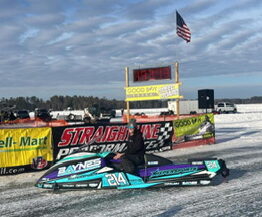To all Racers;
Steel Cleated Tracks are not allowed in NSSR Competition except for the Vintage Classes.
Belted tracks shall be one continuous piece of rubber in width and length. Tracks with multiple belts to comprise one track shall not be allowed.
The use of "Modified Backer Plates" on the outside of the belted tracks up to 11 inches in length and up to 1.250 in width are allowed with the use of aluminum or titanium. Aluminum may be used in a flat configuration up to .125 inches in thickness. The use of titanium may be flat configuration up to .125 inches in thickness.
No U shaped configuration's will be allowed.
The top of the tunnel will still require the use of a .125 inch second plate if the top of the tunnel is not .125 inches or more in thickness.
All "Modified Backer Plates" more than 3.250 inches in length must be approved prior to the race by the Race Director. This approval is to allow the use only, and in no way assumes the liability for the failure of the racers plates or other equipment!
Let me know if you have any questions on this.
Thanks!
Ron
From the way this rule reads, your allowing Cleats as long as they are not manufactured from steel? How did you get ISR to allow or permit this?
If this is the case, it is not good.
and in no way assumes the liability for the failure of the racers plates or other equipment!
By allowing these to be run at any organized event you are taking liability for any failure or damage caused to any spectators or racers on the course. This goes for any component. I would check into the insurance limitations first.
Nate
ISR's biggest issue with Steel Cleats is the weight and the seperate belts on a real cleated track that the slide rails run on. We make no reference to using a steel cleated track, or a cleated track.
The cleat wore where the slide was and also this was a pressure and bending point from the stud on either side of them, causing fracture and hence failure.
Steel cleats were brittle and broke without bending forcing them to tear through the tunnel. The heavy steel cleat outside of a continuous belted track is still an issue because of the weight it has.
NSSR has extended the length of the backer plate from 3.25 inches. Again this can only be placed on the outside of a one-piece continuous rubber belt.
There is more of an issue of putting studs in rubber belted tracks with no stability and them tearing out. These are studs that are put outside of the plate area under the slide and hence the torn out studs then lead to the track ripping.
Racers are putting studs at random location with the higher horspower sleds and this is weakening the track.
NSSR assumes no liability for the performance of the racers equipment.
Insurance is no different in either event.
There has been quite a few calls lately with concerns about hooking up the high horsepower sleds with only 4 studs in each row.
The alternative was to place studs in the belted tracks with no backers on the edges.
NSSR prefers that you stay with the standard plates and from experience, most sleds are fine with 4 studs per row.
The issues is mainly in the exhibition class and the big turbo stuff running the 11 inch wide Dayco track. Racers were already placing 3 sets of plates in the 15 inch wide Camoplast track.
You should be fine with the plates you have in Pro Stock Form.
The new ISR rules do allow the use of 1 inch studs measured above the belt in Pro Stock for 2009-2010 season. So this is a go.
I do apologize for any inconvenience this may cause.
Thanks!
Ron






